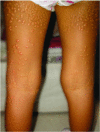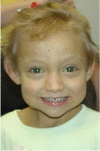Alagille syndrome: clinical perspectives
- PMID: 27418850
- PMCID: PMC4935120
- DOI: 10.2147/TACG.S86420
Alagille syndrome: clinical perspectives
Abstract
Alagille syndrome is an autosomal dominant, complex multisystem disorder characterized by the presence of three out of five major clinical criteria: cholestasis with bile duct paucity on liver biopsy, congenital cardiac defects (with particular involvement of the pulmonary arteries), posterior embryotoxon in the eye, characteristic facial features, and butterfly vertebrae. Renal and vascular abnormalities can also occur. Inter- and intrafamilial variabilities in the clinical manifestations are common. We reviewed the clinical features and management as well as the molecular basis of Alagille syndrome.
Keywords: ALGS; Alagille syndrome; genetics; liver.
Figures



Similar articles
-
Alagille Syndrome and the Liver: Current Insights.Euroasian J Hepatogastroenterol. 2018 Jul-Dec;8(2):140-147. doi: 10.5005/jp-journals-10018-1280. Epub 2019 Feb 1. Euroasian J Hepatogastroenterol. 2018. PMID: 30828556 Free PMC article. Review.
-
Clinical, Laboratory, Radiological, and Genetic Characteristics of Pediatric Patients with Alagille Syndrome.Adv Biomed Res. 2023 Jun 28;12:155. doi: 10.4103/abr.abr_201_22. eCollection 2023. Adv Biomed Res. 2023. PMID: 37564457 Free PMC article.
-
Alagille syndrome.J Med Genet. 1997 Feb;34(2):152-7. doi: 10.1136/jmg.34.2.152. J Med Genet. 1997. PMID: 9039994 Free PMC article. Review.
-
A 10-year-old child presenting with syndromic paucity of bile ducts (Alagille syndrome): a case report.J Med Case Rep. 2016 Nov 30;10(1):342. doi: 10.1186/s13256-016-1126-x. J Med Case Rep. 2016. PMID: 27906097 Free PMC article.
-
Clinical Characterization of Alagille Syndrome in Patients with Cholestatic Liver Disease.Int J Mol Sci. 2023 Jul 21;24(14):11758. doi: 10.3390/ijms241411758. Int J Mol Sci. 2023. PMID: 37511516 Free PMC article.
Cited by
-
Inherited Cholestatic Diseases in the Era of Personalized Medicine.Clin Liver Dis (Hoboken). 2020 Apr 4;15(3):105-109. doi: 10.1002/cld.872. eCollection 2020 Mar. Clin Liver Dis (Hoboken). 2020. PMID: 32257121 Free PMC article. Review.
-
Alagille Syndrome: A Novel Mutation in JAG1 Gene.Front Pediatr. 2019 May 15;7:199. doi: 10.3389/fped.2019.00199. eCollection 2019. Front Pediatr. 2019. PMID: 31157196 Free PMC article.
-
Clinical and genetic analysis in Chinese children with Alagille syndrome.BMC Pediatr. 2022 Nov 29;22(1):688. doi: 10.1186/s12887-022-03750-z. BMC Pediatr. 2022. PMID: 36447191 Free PMC article.
-
Clinical and Laboratory Characteristics in Children with Alagille Syndrome: Experience of a Single Center.Int J Gen Med. 2023 Jan 6;16:77-83. doi: 10.2147/IJGM.S382430. eCollection 2023. Int J Gen Med. 2023. PMID: 36636710 Free PMC article.
-
Novel mutations in NOTCH2 gene in infants with neonatal cholestasis.Pediatr Rep. 2019 Sep 30;11(3):8206. doi: 10.4081/pr.2019.8206. eCollection 2019 Sep 24. Pediatr Rep. 2019. PMID: 31595186 Free PMC article.
References
-
- Spinner N, Leonard L, Krantz I. Alagille syndrome. In: Pagon RA, Adam MP, Ardinger HH, et al., editors. GeneReviews. Seattle, WA: University of Washington; 2013. - PubMed
Publication types
LinkOut - more resources
Full Text Sources
Other Literature Sources

